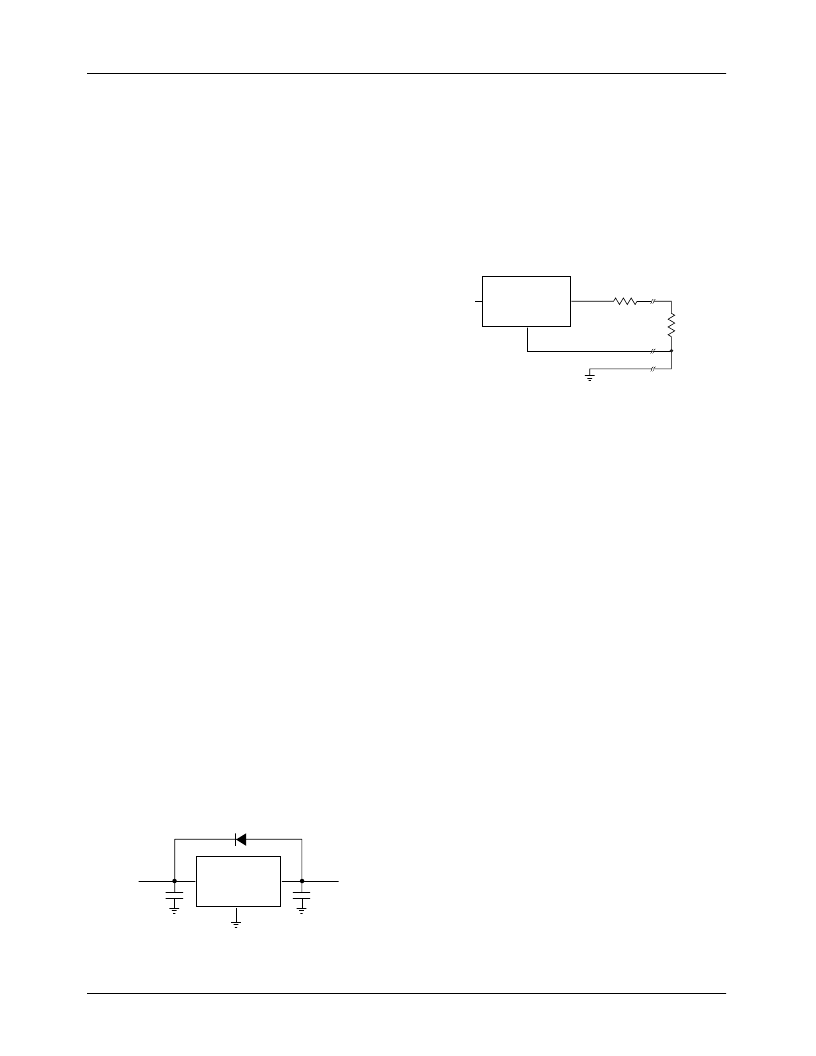- 您現(xiàn)在的位置:買賣IC網(wǎng) > PDF目錄375718 > FAN1589MX (FAIRCHILD SEMICONDUCTOR CORP) FETs - Nch 700V<VDSS; Surface Mount Type: N/Y; Package: TO-220FL/SM; R DS On (Ω): (max 2.2); P D (W): (max 5) PDF資料下載
參數(shù)資料
| 型號: | FAN1589MX |
| 廠商: | FAIRCHILD SEMICONDUCTOR CORP |
| 元件分類: | 基準電壓源/電流源 |
| 英文描述: | FETs - Nch 700V<VDSS; Surface Mount Type: N/Y; Package: TO-220FL/SM; R DS On (Ω): (max 2.2); P D (W): (max 5) |
| 中文描述: | 1.2 V FIXED POSITIVE LDO REGULATOR, 1.3 V DROPOUT, PSSO3 |
| 封裝: | PLASTIC, TO-263, 3 PIN |
| 文件頁數(shù): | 6/12頁 |
| 文件大小: | 82K |
| 代理商: | FAN1589MX |

FAN1589
PRODUCT SPECIFICATION
6
REV. 1.0.3 2/25/02
Applications Information
General
The FAN1589 is a three-terminal regulator optimized for a
GTL+ V
TT
termination applications. It is short-circuit pro-
tected, and offers thermal shutdown to turn off the regulator
when the junction temperature exceeds about 150°C. The
FAN1589 provides low dropout voltage and fast transient
response. Frequency compensation uses capacitors with low
ESR while still maintaining stability. This is critical in address-
ing the needs of low voltage high speed microprocessor buses
like a GTL+.
Stability
The FAN1589 requires an output capacitor as a part of the
frequency compensation. It is recommended to use a 22μF
solid tantalum or a 100μF aluminum electrolytic on the out-
put to ensure stability. The frequency compensation of these
devices optimizes the frequency response with low ESR
capacitors. In general, it is suggested to use capacitors with
an ESR of <1
.
Protection Diodes
In normal operation, the FAN1589 does not require any pro-
tection diodes.
A protection diode between the input and output pins is usu-
ally not needed. An internal diode between the input and out-
put pins on the FAN1589 can handle microsecond surge
currents of 50A to 100A. Even with large value output
capacitors it is difficult to obtain those values of surge cur-
rents in normal operation. Only with large values of output
capacitance, such as 1000
μ
F to 5000
pin instantaneously shorted to ground can damage occur. A
crowbar circuit at the input can generate those levels of cur-
rent; a diode from output to input is then recommended, as
shown in Figure 9. Usually, normal power supply cycling or
system “hot plugging and unplugging” will not generate cur-
rent large enough to do any damage.
μ
F, and with the input
As with any IC regulator, exceeding the maximum input-to-
output voltage differential causes the internal transistors to
break down and none of the protection circuitry is then
functional.
Figure 9. Optional Protection
Load Regulation
It is not possible to provide true remote load sensing because
the FAN1589 is a three-terminal device. Load regulation is
limited by the resistance of the wire connecting the regula-
tors to the load. Load regulation per the data sheet specifica-
tion is measured at the bottom of the package.
For fixed voltage devices, negative side sensing is a true
Kelvin connection with the ground pin of the device returned
to the negative side of the load. This is illustrated in Figure 10.
Figure 10. Connection for Best Load Regulation
Thermal Considerations
The FAN1589 protects itself under overload conditions with
internal power and thermal limiting circuitry. However, for
normal continuous load conditions, do not exceed maximum
junction temperature ratings. It is important to consider all
sources of thermal resistance from junction-to-ambient.
These sources include the junction-to-case resistance, the
case-to-heat sink interface resistance, and the heat sink resis-
tance. Thermal resistance specifications have been developed
to more accurately reflect device temperature and ensure safe
operating temperatures.
For example, look at using an FAN1589 to generate 2.7A @
1.2V
±
2% from a 3.3V source (3.2V to 3.6V).
Assumptions:
V
V
OUT
= 1.176V worst case
I
OUT
= 2.7A continuous
T
A
= 70
°
C
θ
Case-to-Ambient
= 3
°
C/W (assuming both a heatsink and
a thermally conductive material)
The power dissipation in this application is:
IN
= 3.6V worst case
P
D
= (V
IN
– V
OUT
) * (I
OUT
) = (3.6 – 1.18) * (2.7) = 6.53W
From the specification table:
T
J
= T
A
+ (P
D
) * (
θ
Case-to-Ambient
+
θ
JC
)
= 70 + (6.53) * (3 + 3) = 109
°
C
The junction temperature is below the maximum rating.
FAN1589
GND
C2
22
μ
F
V
OUT
C1
10
μ
F
+
+
IN
OUT
D1
1N4002
(OPTIONAL)
V
IN
FAN1589
GND
R
L
R
P
PARASITIC
LINE RESISTANCE
IN
OUT
V
IN
相關PDF資料 |
PDF描述 |
|---|---|
| FAN1616A | 0.5A Adjustable/Fixed Low Dropout Linear Regulator |
| FAN1616AD18X | 0.5A Adjustable/Fixed Low Dropout Linear Regulator |
| FAN1616AD25X | 0.5A Adjustable/Fixed Low Dropout Linear Regulator |
| FAN1616AD33X | 0.5A Adjustable/Fixed Low Dropout Linear Regulator |
| FAN1616AD5X | 0.5A Adjustable/Fixed Low Dropout Linear Regulator |
相關代理商/技術參數(shù) |
參數(shù)描述 |
|---|---|
| FAN1589MX | 制造商:Fairchild Semiconductor Corporation 功能描述:Linear Voltage Regulator IC |
| FAN1589MX_Q | 功能描述:低壓差穩(wěn)壓器 - LDO 2.7A 3 Terminal LDO RoHS:否 制造商:Texas Instruments 最大輸入電壓:36 V 輸出電壓:1.4 V to 20.5 V 回動電壓(最大值):307 mV 輸出電流:1 A 負載調節(jié):0.3 % 輸出端數(shù)量: 輸出類型:Fixed 最大工作溫度:+ 125 C 安裝風格:SMD/SMT 封裝 / 箱體:VQFN-20 |
| FAN1589T | 功能描述:低壓差穩(wěn)壓器 - LDO 2.7A 3 Terminal LDO RoHS:否 制造商:Texas Instruments 最大輸入電壓:36 V 輸出電壓:1.4 V to 20.5 V 回動電壓(最大值):307 mV 輸出電流:1 A 負載調節(jié):0.3 % 輸出端數(shù)量: 輸出類型:Fixed 最大工作溫度:+ 125 C 安裝風格:SMD/SMT 封裝 / 箱體:VQFN-20 |
| FAN1589T_Q | 功能描述:低壓差穩(wěn)壓器 - LDO 2.7A 3 Terminal LDO RoHS:否 制造商:Texas Instruments 最大輸入電壓:36 V 輸出電壓:1.4 V to 20.5 V 回動電壓(最大值):307 mV 輸出電流:1 A 負載調節(jié):0.3 % 輸出端數(shù)量: 輸出類型:Fixed 最大工作溫度:+ 125 C 安裝風格:SMD/SMT 封裝 / 箱體:VQFN-20 |
| FAN1616A | 制造商:FAIRCHILD 制造商全稱:Fairchild Semiconductor 功能描述:0.5A Adjustable/Fixed Low Dropout Linear Regulator |
發(fā)布緊急采購,3分鐘左右您將得到回復。